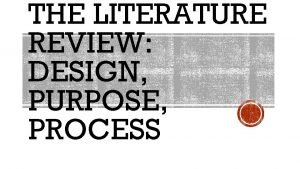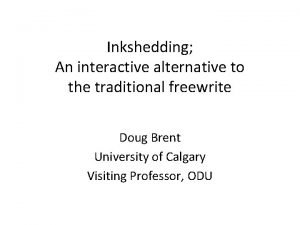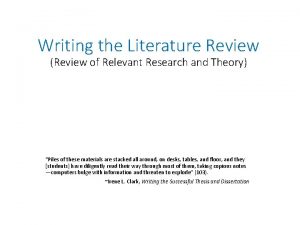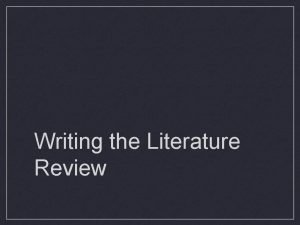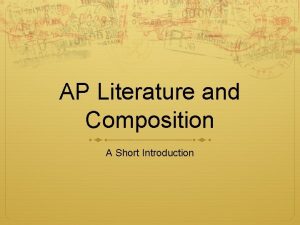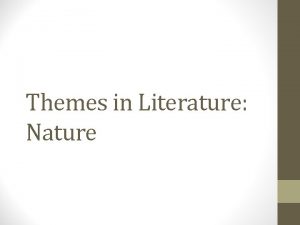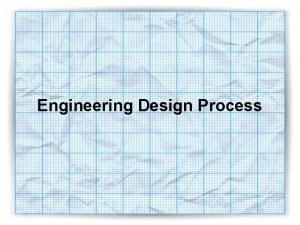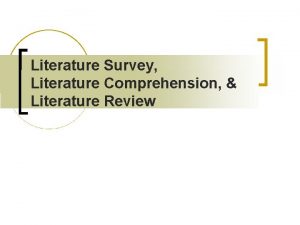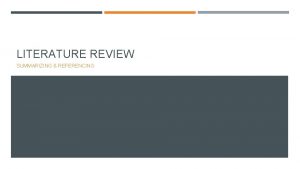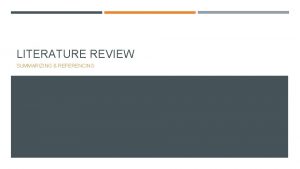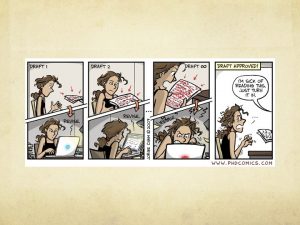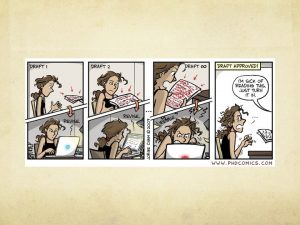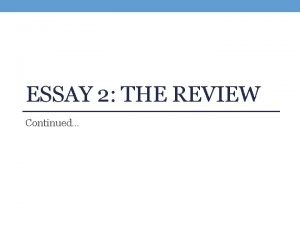THE LITERATURE REVIEW DESIGN PURPOSE PROCESS FREEWRITE What



















- Slides: 19

THE LITERATURE REVIEW: DESIGN, PURPOSE, PROCESS

FREEWRITE ▪ ▪ What is a literature review? What questions (or concerns) do you have about writing a literature review?

WORKSHOP OVERVIEW ▪ Design ▪ Purpose ▪ Process

LITERATURE REVIEWS ARE EVERYWHERE! ▪ In the New Yorker, “Apathetic Children” article

TWO KINDS OF LITERATURE REVIEWS ▪ Lit. reviews that are a section of a larger project (Capstone) ▪ Stand-alone lit. reviews

FIVE APPROACHES TO LITERATURE REVIEWS ▪ Argumentative ▪ Integrative ▪ Historical ▪ Methodological ▪ Theoretical

TWO FACETS OF THE LITERATURE REVIEW PROCESS 1. Conducting a literature review (during the research process) 2. Writing a literature review (as part of a paper)

RESEARCH PROCESS ● Helps you identify what we already know based on existing research. What are the debates? What gaps remain? ● Helps you develop your research question and research design. ▪ What is missing from the research?

BEGINNING RESEARCH AND LIT. REVIEWS ● Brainstorm key terms ● Try out key terms in scholarly databases ● Look for knowledge clusters ▪ Cluster: Home care and labor unions. ▪ Example: Many scholars of home care work focus on the major wave of unionization that swept through this workforce after the 1980 s (Boris and Klein 2012; Delp and Quan 2002; Mareschal 2006, 2007; Ness 1999; Rhee and Zabin 2009)

CHOOSE A LITERATURE REVIEW ▪ What are the clusters in this literature review? ▪ What are some of the key terms?

CHINATOWN LITERATURE REVIEW: CLUSTERS ▪ Intergenerational conflicts and differences in Asian American culture ▪ Role of Chinatown (as ethnic enclave) ▪ Vancouver’s Chinatown ▪ Gentrification and resistance in Chinatown ▪ Gentrification in NY

CHARACTERISTICS OF LITERATURE REVIEW ▪ Does not look like standard “English paper” ▪ Combines summary and synthesis ▪ Example of synthesis: Both Smith (2003) and Johnson (2011) believe that adult day care programs serve important social functions for older adults, but they differ in their assessment of their weaknesses. ▪ Includes salient information about design and methodology research studies (if applicable) ▪ Identifies debates and/or gaps in research

TRANSMILENIO LITERATURE REVIEW: THREE CLUSTERS ▪ Problems with BRT systems worldwide ▪ Methodology of passenger satisfaction studies ▪ Existing research on Trans. Milenio

WHAT ARE YOUR CLUSTERS?

SOLIDIFYING YOUR CLUSTERS ● Which clusters do you need to discuss in order to situate your research in the field or in the conversation? ● What will your research contribute? ● What is your critical analysis of the research?

TIPS FOR CLUSTERING ● Be selective in your articles ● Too much information: focus on recent studies, leading authorities, most relevant studies to your research. ● Too little information: widen your clusters, find a related topic.

BEGINNING TO WRITE ● For articles you are committed to, read and take notes ● Use notes organizer: ▪ Do you agree? Disagree? Is the research inconclusive? Anything missing? ▪ Group similar ideas. Highlight debates. ● Three to five articles per cluster?

WHAT TO EXPECT IN THE PROCESS ▪ Combine clusters ▪ ID a need for new articles ▪ Subtract clusters ▪ Abandon an article

Join us at the SLU Writing Center Website: bit. ly/writingcenteratslu Call: (212) 642 -2014 Email: writingcenter@slu. cuny. edu
 Freewrite review
Freewrite review Alternatives to freewrite
Alternatives to freewrite Definition of review of literature
Definition of review of literature Process design and control design should always be in
Process design and control design should always be in Hát kết hợp bộ gõ cơ thể
Hát kết hợp bộ gõ cơ thể Frameset trong html5
Frameset trong html5 Bổ thể
Bổ thể Tỉ lệ cơ thể trẻ em
Tỉ lệ cơ thể trẻ em Voi kéo gỗ như thế nào
Voi kéo gỗ như thế nào Chụp phim tư thế worms-breton
Chụp phim tư thế worms-breton Alleluia hat len nguoi oi
Alleluia hat len nguoi oi Môn thể thao bắt đầu bằng chữ đua
Môn thể thao bắt đầu bằng chữ đua Thế nào là hệ số cao nhất
Thế nào là hệ số cao nhất Các châu lục và đại dương trên thế giới
Các châu lục và đại dương trên thế giới Công thức tính độ biến thiên đông lượng
Công thức tính độ biến thiên đông lượng Trời xanh đây là của chúng ta thể thơ
Trời xanh đây là của chúng ta thể thơ Mật thư anh em như thể tay chân
Mật thư anh em như thể tay chân 101012 bằng
101012 bằng độ dài liên kết
độ dài liên kết Các châu lục và đại dương trên thế giới
Các châu lục và đại dương trên thế giới
